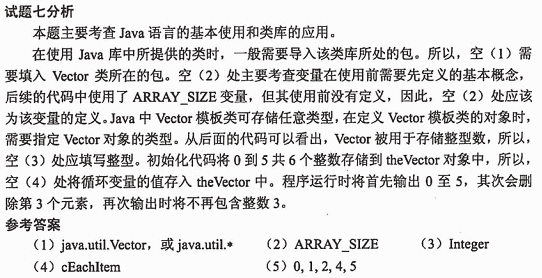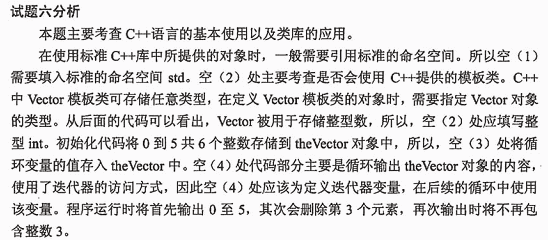阅读以下说明和Java代码,填补空缺。[说明]java.util库中提供了Vector模板类,可作为动态数组使用,并可容纳任意数据类型。该类的部分方法说明如下所示:方法名 含义add(k) 向vector对象的尾部添加一个元素kremoveElementAt(i) 删除序号为i的元素(vector元素序号从0开始)isEmpty( ) 判断vector对象是否含有元素size( ) 返回vector对象中所包含的元素个数[Java代码]Import ________;public class JavaMa
题目
阅读以下说明和Java代码,填补空缺。
[说明]
java.util库中提供了Vector模板类,可作为动态数组使用,并可容纳任意数据类型。
该类的部分方法说明如下所示:
方法名 含义
add(k) 向vector对象的尾部添加一个元素k
removeElementAt(i) 删除序号为i的元素(vector元素序号从0开始)
isEmpty( ) 判断vector对象是否含有元素
size( ) 返回vector对象中所包含的元素个数
[Java代码]
Import ________;
public class JavaMain {
static private final int ________ =6;
public static void main(String[]args) {
Vector theVector=new Vector< _______ >( );
//初始化theVector,将theVector的元素设置为0至5
for(int cEachItem=0; cEachItem<ARRAY_SIZE; cEachItem++)
theVector. add( ________ );
showVector(theVector); //依次输出theVector巾的元素
theVector. removeElementAt(3);
showVector(theVector);
}
public static void showVector(Vector theVector){
if(theVector. isEmpty( )){
System.out.printin("theVector is empty.");
return;
}
for(int loop=0; loop<theVector.size( ); loop++) {
System.out.print(theVector.get(loop));
System.out.print(",");
}
System.out.printin( );
}
}
该程序运行后的输出结果为:
0, 1, 2, 3, 4, 5
___________
相似考题
参考答案和解析
java.util.Vector或java.util.* ARRAY_SIZE Integer cEachItem 0,1,2,4,5 解析:本题考查的是Java语言的基本应用。在使用Java库中的类时,要导入类所在的包,(1)处应为java.util.Vector或java.util.*。(2)处考查的是变量的定义,此处应为ARRAY_SIZE。(3)处是考察Vector模板类存储的数据类型,所以此处应为Integer类型,(4)处代码主要是将循环变量的值存入cEachItern中,因此应为cEachItem。程序开始会输出0,1,2,3,4,5,再次输出时则没有3,应为0,1,2,4,5。
更多“阅读以下说明和Java代码,填补空缺。[说明] java.util库中提供了Vector模板类,可作为动态数组使用, ”相关问题
-
第1题:
阅读以下说明和Java程序,填补代码中的空缺(1)~(6),将解答填入答题纸的
对应栏内。
【说明】
很多依托扑克牌进行的游戏都要先洗牌。下面的Java代码运行时先生成一副扑克
牌,洗牌后再按顺序打印每张牌的点数和花色。
【Java代码】

 正确答案:
正确答案:
本题考查Java语言程序设计的能力,涉及类、对象、方法的定义和相关操作。要求考生根据给出的案例和代码说明,认真阅读,理清程序思路,然后完成题目。先考查题目说明。本题目中涉及到扑克牌、牌桌、玩家等类以及洗牌和按点数排序等操作。根据说明进行设计。Card类内定义了两个static枚举类型,Face枚举扑克牌点数,Suit枚举扑克牌花色。Card类有两个枚举类型的属性,face和suit,而且值不再变化,故用final修饰。在使用构造方法publicCard(Faceface,Suitsuit)新建一个Car:d的对象时,所传入的参数指定face和suit这两个属性值。因为参数名称和属性名称相同,所以用this前缀区分出当前对象。在类Card中包含方法getFace()和getSuit(),分别返回当前对象的face和suit属性值。getCard()方法返回string来表示一张牌,包括扑克牌点数和花色。牌桌类Deckofcands包含持有Card类型元素的List类型对象的声明List,用以存储牌。List是Java中的一种集合接口,是Collection的子接口。构造方法中用Card对象填充牌桌并进行洗牌。先用Card对象填充牌桌,即创建52个Card对象加入deck数组,表示牌桌上一副牌(52张)。然后洗牌,即将数组中的Card对象根据花色和点数随机排列,使用集合工具类Collechons中的shuffle方法,对以List类型表示的deck数组进行随机排列。Collectians是Java集合框架中两个主要工具类之一,用以进行集合有关的操作。printCards()方法将所有Card对象打印出来,按4列显示52张牌。每张拍的打印用list.get(i)获得list表示的deck中的第i个Card对象,然后进一步调用此对象的getCard()方法,得到String表示的当前一张牌。玩家类中包括启动发牌洗牌等操作,主入口方法main中实现创建牌桌对象,并调用按4列显示52张牌。在main()中,先初始化Deckofcards类的对象player,即生成一个牌桌:Deckofcardsplayer=newDeckofcards()并发牌,即调用player的printCards()方法,实现按4列显示52张牌打印一副扑克牌中每张牌的点数和花色。在pnntCards()方法体内部,用list调用每个数组元素,井为每个数组元素调用getCard()返回当前对象所表示一张牌的花色和点数。用格式化方法进行打印,即:因此,主(1)和(2)需要表示当前对象的this.;空(3)需要牌桌上纸牌对象,并将数组元素下标加1,即数组元素deck[count++];空(4)也需要用list对象获得纸牌对象的字符串表示,即list后的get(1)getCard();空(5)处为创建DeckOf℃ards类的对象指针player的newDeckOfCards();空(6)需要用对象player调用打印所有纸牌的printCards()函数,即player.。试题六参考答案(l)this(2)this.(3)deck[count++]或等价表示(4)get(i)getCard()(5)newDeckOfCards()(6)player. -
第2题:
试题七(共 15 分)
阅读以下说明和 Java 代码,将应填入 (n) 处的字句写在答题纸的对应栏内。
[说明]
java.util 库中提供了 Vector 模板类,可作为动态数组使用,并可容纳任意数据类型。该类的部分方法说明如下表所示:

[Java 代码]
import (1) ;
public class JavaMain {
static private final int (2) = 6;
public static void main(String[] args){
Vector<Integer> theVector = new Vector< (3) >();
// 初始化 theVector,将 theVector的元素设置为 0 至 5
for (int cEachItem = 0; cEachItem < ARRAY_SIZE; cEachItem++)
theVector.add( (4) );
showVector(theVector); // 依次输出 theVector中的元素
theVector.removeElementAt(3);
showVector(theVector);
}
public static void showVector(Vector<Integer> theVector){
if (theVector.isEmpty()) {
System.out.println("theVector is empty.");
return;
}
for (int loop = 0; loop < theVector.size(); loop++) {
System.out.print(theVector.get(loop));
System.out.print(", ");
}
System.out.println();
}
}
该程序运行后的输出结果为:
0, 1, 2, 3, 4, 5
(5)
正确答案:
-
第3题:
java.util包中提供了一个专门用来操作集合的工具类,这个类是()
Arrays -
第4题:
试题六(共 15 分)
阅读以下说明和 C++代码,将应填入 (n) 处的字句写在答题纸的对应栏内。
[说明]
C++标准模板库中提供了 vector 模板类,可作为动态数组使用,并可容纳任意数据类型,其所属的命名空间为 std。vector模板类的部分方法说明如下表所示:

[C++代码]
include <iostream>
include <vector>
using namespace (1) ;
typedef vector< (2) > INTVECTOR;
const int ARRAY_SIZE = 6;
void ShowVector(INTVECTOR &theVector);
int main(){
INTVECTOR theVector;
// 初始化 theVector,将 theVector的元素依次设置为 0 至 5
for (int cEachItem = 0; cEachItem < ARRAY_SIZE; cEachItem++)
theVector.push_back( (3) );
ShowVector(theVector); // 依次输出 theVector中的元素
theVector.erase(theVector.begin() + 3);
ShowVector(theVector);
}
void ShowVector(INTVECTOR &theVector) {
if (theVector.empty()) {
cout << "theVector is empty." << endl; return;
}
INTVECTOR::iterator (4) ;
for (theIterator = theVector.begin(); theIterator != theVector.end(); theIterator++){
cout << *theIterator;
if (theIterator != theVector.end()-1) cout << ", ";
}
cout << endl;
}
该程序运行后的输出结果为:
0, 1, 2, 3, 4, 5
(5)
正确答案:

-
第5题:
java.util包中提供了一个专门用于操作数组的工具类,这个类是()。
Arrays
